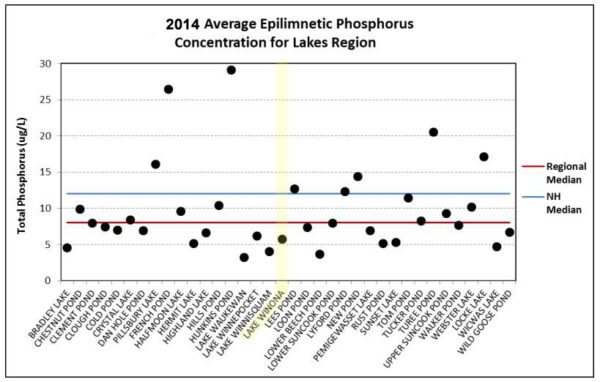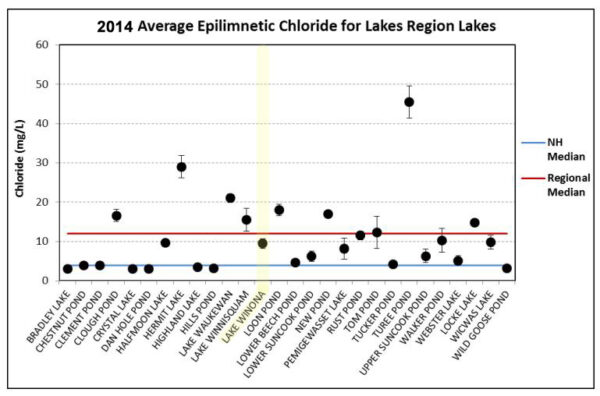Water Quality Reports
Ongoing monitoring and evaluating lake water quality is critical to the long-term protection of our precious Lake Winona. Our lake participates in the NH Department of Environmental Services’ (NHDES) Volunteer Lake Assessment Program (VLAP) and collects three samplings each summer, once in June, July and August. If you would like to join the Water Quality Committee, please contact Mark or Linda Heminway, Committee Chairs.
2024 NHDES VLAP Recommendations
Great job monitoring water quality in 2024! Algal growth (chlorophyll-a) has significantly increased in the lake, particularly since 2012. Due to the history of cyanobacteria surface scums, keep an eye on the lake for any unusual signs of algal/cyanobacteria growth and report to NHDES Harmful Algal Bloom Program. Phosphorus levels have significantly increased in the Hypolimnion, suggesting an organic layer on the lake bottom that depletes dissolved oxygen, resulting in the release of phosphorus bound in lake sediments. The increased intensity of storm events and fluctuating climate conditions, resulting in shorter periods of ice cover, warmer water temperatures, and longer periods of thermal stratification, can impact pond quality over time and accelerate the eutrophication process. This highlights the importance of minimizing stormwater runoff, erosion, sedimentation, and deposition of organic material to the lake from the surrounding watershed. Encourage shoreline property owners to maintain a good vegetative buffer to help reduce stormwater runoff to the lake and minimize shoreline erosion from wave action. NHDES NH Homeowner’s Guide to Stormwater Management and UNH Cooperative Extension’s Landscaping at the Water’s Edge are good resources. Keep up the great work! You can read the full 2024 report here.
2023 NHDES VLAP Recommendations
Great job sampling in 2023! Algal growth (chlorophyll-a) has significantly increased in the lake, particularly since 2012 and levels have generally remained above the threshold for mesotrophic lakes. Similar to record summer rainfall amounts in 2021, the excessive summer rainfall in 2023 seemed to help flush nutrients out of the system resulting in lower levels of algal growth, however water clarity was poor, likely due to darker water color. Due to the history of cyanobacteria surface scums, keep an eye on the lake for any unusual signs of algal/cyanobacteria growth and report to NHDES’ Harmful Algal Bloom Program. Phosphorus levels have significantly increased in the Hypolimnion suggesting an organic layer on the lake bottom that depletes dissolved oxygen resulting in release of phosphorus bound in lake sediments. This highlights the importance of minimizing stormwater runoff, erosion, sedimentation, and deposition of organic material to the lake from the surrounding watershed. Encourage shoreline property owners to maintain a good vegetative buffer to help reduce stormwater runoff to the lake and minimize shoreline erosion from wave action. You can read the full 2023 report here.
August 2023 Raw data test results
Our August results are back from the NH DES. It may be easier to look at the Water Quality over time page to spot the trends, but if you are interested in the full data it is available here. In general we are about where we have been historically.
2022 NHDES VLAP Recommendations
Great job sampling in 2022! Algal growth (chlorophyll-a) has significantly increased in the lake, particularly since 2012 when levels have generally remained above the threshold for mesotrophic lakes. In contrast with record summer rainfall amounts in 2021 that helped to flush nutrients out of the system, drought conditions in 2022 likely resulted in nutrients being retained in the lake and in the elevated algal growth in August. Due to the history of cyanobacteria surface scums, keep an eye on the lake for any unusual signs of algal/cyanobacteria growth and report to NHDES’ Harmful Algal Bloom Program. Phosphorus levels have significantly increased in the Hypolimnion, suggesting an organic layer on the lake bottom that depletes dissolved oxygen, resulting in the release of phosphorus bound in lake sediments. This phosphorus is readily available for uptake by algae/cyanobacteria and highlights the importance of minimizing stormwater runoff, erosion, sedimentation and deposition of organic material to the lake from the surrounding watershed. Encourage shoreline property owners to maintain a good vegetative buffer to help reduce stormwater runoff to the lake and minimize shoreline erosion from wave action. NHDES’ NH Homeowner’s Guide to Stormwater Management and UNH Cooperative Extension’s Landscaping at the Water’s Edge are good resources. Lake conductivity levels have increased and are likely being driven by road salt usage on local roadways, particularly in the sub-watersheds of Hawkins Pond Inlet and Chutes Cove. Encourage local winter maintenance companies to obtain Green SnowPro Certification to help address increasing conductivity/chloride levels Keep up the great work!
The full report is available here
Here is information to understand the numbers and trends here.
2021 NHDES VLAP Recommendations
Algal growth (chlorophyll-a) has significantly increased in the lake, particularly since 2012 when levels have generally remained above the threshold for mesotrophic lakes. Record rainfall amounts in July, 2021 may have helped to flush nutrients out of the system as no cyanobacteria blooms were reported. However, historical data suggest more frequent occurrence of summer algal/cyanobacteria blooms and potential increased dominance of cyanobacteria in the phytoplankton population. Phosphorus levels have significantly increased in the Hypolimnion suggesting a thick organic layer on the lake bottom that depletes dissolved oxygen resulting in release of phosphorus bound in lake sediments. This phosphorus is readily available for uptake by algae/cyanobacteria and highlights the importance of minimizing stormwater runoff, erosion, sedimentation and deposition of organic material to the lake. Encourage shoreline property owners to maintain a good vegetative buffer to help reduce stormwater runoff to the lake and shoreline erosion from wave action. NHDES’ NH Homeowner’s Guide to Stormwater Management and UNH Cooperative Extension’s Landscaping at the Water’s Edge are good resources. Lake conductivity levels have increased and likely being driven by road salt usage on local roadways. Encourage local winter maintenance companies to obtain Green SnowPro Certification to help address increasing conductivity/chloride levels.
The full report is available here.
2020 NHDES VLAP Recommendations
There is a pretty significant increase in phosphorus levels in the lake. Generally phosphorus is caused by runoff from the surrounding land area, with septic systems and heavy rains on vegetation cleared areas being the primary drivers. The general action of the increased phosphorus is an increase in algae bloom probability and a depletion of the free oxygen in the lake (bad for fish and plants).
The condensed version of the NHDES report is:
Algal growth (chlorophyll-a) has significantly increased in the lake, particularly since 2012 when levels have generally remained above the threshold for mesotrophic lakes. The lake experienced a cyanobacteria bloom again in 2020 and historical data suggest more frequent occurrence of summer algal/cyanobacteria blooms. Phosphorus levels have significantly increased in the Hypolimnion suggesting a thick organic layer on the lake bottom that depletes dissolved oxygen resulting in release of phosphorus bound in the sediments into the water column. This phosphorus is readily available for uptake by algae and cyanobacteria. This highlights the importance of minimizing stormwater runoff, erosion, and sedimentation and deposition of organic material to the lake. Encourage shoreline property owners to maintain a good vegetative buffer to help reduce stormwater runoff to the lake and shoreline erosion from wave action. DES’ “NH Homeowner’s Guide to Stormwater Management” and UNH Cooperative Extension’s “Landscaping at the Water’s Edge” are good resources.
The full report is available on the DES site here – 2020-winona-new-hampton.pdf (state.nh.us)
2019 NHDES VLAP Recommendations
Lake quality was good in June with phosphorus and chlorophyll levels below the thresholds for mesotrophic lakes, however, historical data suggest the occurrence of late summer algal/cyanobacteria blooms and phosphorus levels have significantly increased in the Hypolimnion suggesting a thick organic layer on the lake bottom that depletes dissolved oxygen resulting in the release of phosphorus bound in the sediments into the water column. This phosphorus is readily available for uptake by algae and cyanobacteria. This highlights the importance of minimizing stormwater runoff, erosion, and sedimentation and deposition of organic material to the lake. Educate lake residents on best practices to dispose of organic material and how to reduce stormwater runoff and shoreline erosion. Identify and catalog areas prone to erosion and prioritize areas for remediation activities. Keep up the great work!
2017 NHDES VLAP Recommendations
Recommended Actions: Lake chlorophyll levels (algal growth) has remained above the threshold for mesotrophic lakes since 2010, and this is likely due to the spikes in algal growth typically measured in September during the start of the fall turnover when nutrients from bottom waters become available for algal growth. This highlights the importance of minimizing nutrient inputs from the watershed during the summer months. Several tributaries experienced higher phosphorus levels following a storm event in July, and bacteria levels also spiked. These systems are fed by wetland complexes and the influx of nutrients and bacteria may be a normal occurrence following heavy rainfall. These events may be occurring more frequently and highlight the importance of managing stormwater runoff from lake and watershed properties, and dirt/gravel and paved roads. Encourage lake property owners and those responsible for road maintenance to implement stormwater best practices to reduce stormwater runoff and erosion from their properties. Keep up the great work.
Download the 2017 VLAP Report (individual summary report not produced in 2018)
2014 Lakes Region Regional VLAP Report on Total Phosphorus Levels
Phosphorus is typically the limiting nutrient for vascular plant and algal growth in New Hampshire’s lakes and ponds. Excessive phosphorus in a pond can lead to increased plant and algal growth over time. The median summer epilimnetic (upper layer) total phosphorus concentration of New Hampshire’s lakes and ponds is 12 ug/L. The median epilimnetic total phosphorus concentration for the Lakes region is 8 ug/L.
2014 Lakes Region Regional VLAP Report on Total Chlorophyll-a
Algae are microscopic plants that are naturally found in the lake ecosystem. Algae and cyanobacteria contain chlorophyll-a, a pigment used for photosynthesis. The measurement of chlorophyll-a in the water provides an estimation of the algal and/or cyanobacteria abundance or lake productivity. The median summer chlorophyll-a concentration for New Hampshire’s lakes and ponds is 4.58 mg/m3. The median chlorophyll-a concentration for the Lakes Region is 3.83 mg/m3.
Additional NHDES VLAP Reports for Lake Winona
-
- 2016 NHDES VLAP Report
- 2015 NHDES VLAP Report
- 2014 Lakes Region Regional NHDES VLAP Report
- 2014 NHDES VLAP Report
- 2013 NHDES VLAP Report
- 2012 NHDES VLAP Report
- 2011 Lakes Region Regional NHDES VLAP Report
- No report available for 2010
- 2009 NHDES VLAP Report
- 2008 NHDES VLAP Report
- 2007 NHDES VLAP Report
- 2006 NHDES VLAP Report

